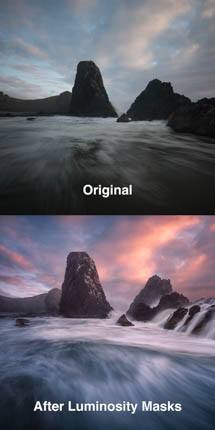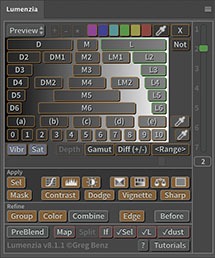Even though I’ve come a long way as an artist, I still find it can be challenging to find the right color to enhance my image. That might be because I’m unsure which color to blend with existing color. Or perhaps I’m stuck in a rut and having a creative block. You might find that some of Photoshop’s adjustment layers (such as Selective Color or even using Curves to generate color) are a bit tricky.
My friend and professional portrait retoucher Pratik Naik has created an awesome software add on for Photoshop called the “Infinite Color Panel” (or “ICP”) to help get great color and creative inspiration. So in this tutorial, I wanted to demonstrate how it works and how you can take fully advantage of it it by customizing the results, including with the use of Lumenzia to generate luminosity masks or BlendIf for more targeted results.
I’ve also coordinated with Pratik to allow you to get ICP at a great discount (this also includes the bundle for his other similarly creative Black and White panel). Through April 7, use “GREG40” for $40 off ICP during checkout, or “GREGBUNDLE” for $15 off the ICP + BW bundle. Use the blue button above for more details or to get ICP or the ICP + BW bundle.
How to generate great color in ICP
ICP has several options below the “Create” button. Anything that is brighter white is selected. Here are the various options and how to use them:
- Light / Medium / Intense controls the strength of the effect. If you are trying to get the result in one go, you might choose the lesser options – but I prefer to just always use “Intense”. I then use opacity as outlined below to reduce the effect if needed. And when using luminosity masks or BlendIf, the strength is naturally dialed down a bit, so it helps to use stronger adjustments to start.
- Curves is great for adjusting both color and luminosity. This is an ideal starting point for adding some punch to the image.
- Color Balance is somewhat similar to curves, but with less effect on the luminosity. This is a great way to create a more unified color across the image, and I like to start cycling through color balance variations after finding an ideal curve.
- Selective Color adds a lot of color to the shadows. This is great if you want to create a stylized look, but it probably isn’t something you’ll use on a lot of landscape images and the opacity should generally be turned down.
- Gradient Map has a lot in common with Selective Color, as it also affects the shadow color a bit- but also changes color more evenly across highlights and shadows. This is also something you may not use as much for landscape images.
- Color Lookup is great for controlling contrast and tonality of the image. I like to cycle through the options here after setting Curves or Color Balance first.
- Harmonize. This helps push the image towards a color triad based on the dominant highlight color. If you want to create a bit of that hipster color filter look you get on sites like Instagram, give it a try. This is a self-contained option that is otherwise unrelated to the other options.
- The Shuffle column is a way to cycle through different versions of a specific layer you have already created (without changing all the layers in the ICP group), or to add an effect to an existing group. It is also not a setting that you turn off/on. See the demo video on this page to get a better feel for this.
Once you have the options you want, click “Create” to start generating the requested adjustment layers. Keep clicking the “Create” until you get a look that is headed in a good direction. It does not need to be perfect at this stage, the goal is a good starting point. And if you want to go back to a variation you blew past, just use the history panel in Photoshop (or undo shortcut keys).
How to refine the color
Once you have you have a group of layers that looks promising, you can start to tweak the results. Here are a few adjustments to consider:
- If the overall result is too strong, turn down the opacity of either the group or of individual layers in the group for even more control.
- If the color is close but perhaps too blue, magenta, etc: try turning off and on various layers to find which one is causing the unwanted color. You may then tweak its settings, reduce the opacity, or delete/hide it to remove it completely.
- If you only need the effect in one part of the image, add a layer mask to the group (or a specific layer) and paint it in just where you want to reveal the adjustment. Great options to do this include soft brushes or the radial/linear gradients, as all of these allow you to create a soft transition for a natural look.
Of course, this last option for using a layer mask can be taken even further by using Lumenzia to create luminosity masks.
How to refine the color with Lumenzia
The sort of adjustments you get from the ICP often work even better if you apply them specifically to the shadows or highlights in the image. That makes the use of both ICP and Lumenzia a powerful combination. ICP helps you create great color and Lumenzia can help you apply it where it looks the best.
There are two key workflows I recommend here: luminosity masks on the group, or BlendIf on the individual layers in the group. Luminosity masks have the benefit of giving you additional control and can be applied in one place on the group (something that Photoshop does not currently support for BlendIf). And BlendIf gives you the benefit of smaller files that are more flexible (as you may need to update a luminosity mask if you change the image content in the layers below the ICP adjustment).
The basic workflow for using the group luminosity mask approach with Lumenzia is:
- Select the group layer
- Click on the various previews (D1-D5 or L1-L5) in Lumenzia to find the best targeting of highlights or shadows. You may use the slider or tweak the orange levels layer to further customize the preview.
- Once you have the preview you’d like to use, just click “Mask” to apply it as a mask on the group.
The basic workflow for using the BlendIf approach with Lumenzia is:
- Select the layer you wish to adjust. You may also apply the same BlendIf to multiple layers by holding <ctrl/cmd> or <shift> while clicking to select multiple layers.
- Be sure you do not select the group. If you add any BlendIf to it, the result is that none of the adjustment layers in the group will have any effect on the image. This is like making the group invisible, and is unfortunately just how Photoshop treats BlendIf on groups (to be more specific, it treats the group as if you changed the blend mode to “normal”, where adjustment layers cannot affect anything outside the group).
- Either <shift>-click the desired BlendIf (D1-D5 or L1-L5) in Lumenzia, or change the panel mode to “If:under” and click on the same button. This will immediately apply the BlendIf.
- You may now customize the BlendIf by dragging the blue sliders in Lumenzia. (If you see a white slider, that is because the target layer’s layer mask is active and Lumenzia is trying to feather it. Just click on the layer outside the mask to stop targeting the mask, and the slider will turn blue for BlendIf adjustment).
- If you would like to visualize the BlendIf, you may click the red “If” button at the bottom of Lumenzia to see a color overlay of the affected areas. <shift>-click “If” to change the color of the overlay.
- Alternatively (if you are more comfortable with viewing layer masks), you may <ctrl/cmd>-click the “Mask” button in Lumenzia to convert the BlendIf temporarily to the equivalent layer mask. (Just be sure to undo if you want to stick with using BlendIf, this is just a way to visualize the BlendIf, not a way to adjust it).
Next steps
I often create several ICP adjustments. Either to build on something I’ve started or because I want different effects in different parts of the image. The key is to create a new ICP group, and there are a few important things to know about how ICP and Lumenzia work:
- If you have a group named “Infinite Color”, it will be used every time you click “Create”. If you like what you have created and want ICP to use a new group, just rename the group to anything else.
- If you use Lumenzia to add a luminosity mask, it will rename the layer to add the name of the luminosity mask used. This will give you a name like “D2 Infinite Color”. As a result, clicking “Create” in ICP would then start generating a new group.
- If you want to be able to mask the group and keep cycling through ICP options, you may rename the group back to “Infinite Color” (exactly with that spelling and no extra spaces).
- Or, you may go to Lumenzia’s menu and uncheck the option labeled “add luminosity mask name to layer name via Mask”. Once that is unchecked, Lumenzia will stop renaming layers when you use the “Mask” button.
Disclosure:
This article contains affiliate links and Pratik provided me with a free copy of ICP to evaluate. See my ethics statement for more information.
I’ve also coordinated with Pratik to allow you to get ICP at a great discount (this also includes the bundle for his other similarly creative Black and White panel). Through April 7, use “GREG40” for $40 off ICP during checkout, or “GREGBUNDLE” for $15 off the ICP + BW bundle. Use the blue button above for more details or to get ICP or the ICP + BW bundle.

